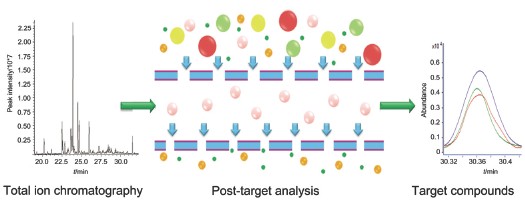| [1] Hernandez, F.; Portoles, T.; Pitarch, E.; Lopez, F. J. Anal. Chem. 2007, 79, 9494.[2] Zhang, F.; Yu, C.-T.; Wang, W.-W.; Fan, R.-J.; Zhang, Z.-X.; Guo, Y.-L. Anal. Chim. Acta 2012, 757, 39.[3] Kang, W.-Y.; Zhang, F.; Su, Y.; Guo, Y.-L. Eur. J. Mass Spectrom. 2013, 19, 103.[4] Gomez, M. J.; Gomez-Ramos, M. M.; Aguera, A.; Mezcua, M.; Herrera, S.; Fernandez-Alba, A. R. J. Chromatogr. A 2009, 1216, 4071.[5] Li, Y.; Ruan, Q.; Li, Y.-L.; Ye, G.-Z.; Lu, X.; Lin, X.-H.; Xu, G.-W. J. Chromatogr. A 2012, 1255, 228.[6] Wang, C.-Z.; Su, Y.; Guo, Y.-L. Chin. J. Org. Chem. 2009, 29, 948. (王呈仲, 苏越, 郭寅龙, 有机化学, 2009, 29, 948.)[7] Su, Y.; Wang, C.-Z.; Guo, Y.-L. Acta Chim. Sinica 2009, 67, 546. (苏越, 王呈仲, 郭寅龙, 化学学报, 2009, 67, 546.)[8] Liu, S.-H.; Wang, C.-Z.; Su, Y.; Guo, Y.-L. J. Instrum. Anal. 2010, 29(2), 126. (刘素红, 王呈仲, 苏越, 郭寅龙, 分析测试学报, 2010, 29(2), 126.)[9] Wang, C.-Z.; Su, Y.; Li, D.; Cai, B.; Guo, Y.-L. Anal. Lett. 2010, 43, 2297.[10] Zhu, F.-J.; Guo, Y.-L. Chin. J. Chem. 2010, 28, 1451.[11] Su, Y.; Ji, H.-W.; Su, S.-B.; Guo, Y.-L. Anal. Test. Tech. Instrum. 2008, 14, 131. (苏越, 姬厚伟, 苏式兵, 郭寅龙, 分析测试技术与仪器, 2008, 14, 131.)[12] Xian, F.; Hendrickson, C. L.; Marshall, A. G. Anal. Chem. 2012, 84, 708.[13] Wang, H.; Wang, H.-Y.; Zhang, L.; Zhang, J.; Guo, Y.-L. Anal. Chim. Acta 2011, 690, 1.[14] Johnson, J. V.; Yost, R. A. Anal. Chem. 1985, 57, 758.[15] Wang, H.-Y.; Guo, Y.-L. J. Mass. Spectrom. 2011, 46, 856.[16] Leng, J.-P.; Wang, H.-Y.; Zhang, L.; Zhang, J.; Guo, Y.-L. Chin. J. Chem. 2010, 28, 1751.[17] Hong, S.-S.; Kang, W.-Y.; Su, Y.; Guo, Y.-L. Chin. J. Chem . 2013, 31, 1329.[18] Lu, S.-S.; Su, Y.; Guo, Y.-L. Eur. J. Mass Spectrom. 2011, 17(4), 353.[19] Liu, S.-H.; Lu, S.-S.; Su, Y.; Guo, Y.-L. Chromatographia 2011, 74, 497.[20] Portoles, T.; Pitarch, E.; Lopez, F. J.; Sancho, J. V.; Hernandez, F. J. Mass Spectrom. 2007, 42, 1175.[21] Cervera, M. I.; Portoles, T.; Pitarch, E.; Beltran, J.; Hernandez, F. J. Chromatogr. A 2012, 1244, 168.[22] Serrano, R.; Nacher-Mestre, J.; Portoles, T.; Amat, F.; Hernandez, F. Talanta 2011, 85, 877.[23] Redeuil, K.; Smarrito-Menozzi, C.; Guy, P.; Rezzi, S.; Dionisi, F.; Williamson, G.; Nagy, K.; Renouf, M. J. Chromatogr. A 2011, 1218, 4678.[24] Portoles, T.; Pitarch, E.; Lopez, F. J.; Hernandez, F. J. Chromatogr. A 2011, 1218, 303.[25] Fan, R.-J.; Zhang, F.; Wang, H.-Y.; Zhang, L.; Zhang, J.; Zhang, Y.; Yu, C.-T.; Guo, Y.-L. Sci. China, Ser. B: Chem. 2013, 56, 1.[26] The Pharmacopoeia Committee of the People's Republic of China, The Pharmacopoeia of the People's Republic of China, 1st ed., Chemical Industry Press, Beijing, 2010. (中华人民共和国药典(一部), 化学工业出版社, 北京, 2010.)[27] Yi, M.-H.; Xiao, H.; Liang, Z.-Y. China Trop. Med. 2004, 4(3), 339. (易美华, 肖红, 梁振益, 中国热带医学, 2004, 4(3), 339.) [28] Lin, J.-M.; He, W.; Wu, M.-M.; Wu, Z.; Fu, T.-H.; Xia, P.-G.; Chen, F.-L. J. Chin. Med. Mater. 2000, 23(8), 448. (林敬明, 贺巍, 吴旻明, 吴忠, 付庭焕, 夏平光, 陈飞龙, 中药材, 2000, 23(8), 448.)[29] Luo, X.-Z.; Yu, J.-G.; Xu, L.-Z.; Yang, S.-L.; Feng, J.-D.; Ou, S.-L. China J. Chin. Mater. Med. 2001, 26(4), 262. (罗秀珍, 余竞光, 徐丽珍, 杨世林, 冯锦东, 欧淑玲, 中国中药杂志, 2001, 26(4), 262.)[30] Morikawa, T.; Matsuda, H.; Toguchida, I.; Ueda, K.; Yoshikawa, M. J. Nat. Prod. 2002, 65(10), 1468.[31] Shoji, N.; Umeyama, A.; Asakawa, Y.; Takemoto, T.; Nomoto, K.; Ohizumi, Y. J. Pharm. Sci. 1984, 73, 843.[32] Adams, R. P.; Habte, M.; Park, S.; Dafforn, M. R. Biochem. Syst. Ecol. 2004, 32, 1137.[33] Huang, W.-Q.; Hu, C.-J.; Li, X.-Y.; Li, X.-H.; Yang, Z.-K.; Xie, X.-Q.; Peng, K.-C. China Pharm. 2008, 17(5), 3. (黄勤挽, 胡昌江, 李兴迎, 李兴华, 杨宗锟, 谢秀琼, 彭克成, 中国药业, 2008, 17(5), 3.)[34] Morteza-Semnani, K.; Saeedi, M. Flavour Fragr. J. 2005, 20, 332.[35] Yang, B.; Li, X.-B. Cent. South Pharm. 2010, 8(11), 817. (阳波, 李湘斌, 中南药学, 2010, 8(11), 817.)[36] Javidnia, K.; Miri, R.; Kamalinejad, M.; Mehdipour, A. R. J. Essent. Oil Res. 2006, 18, 86.[37] Maia, J. G. S.; Andrade, E. H. A.; da Silva, A. C. M.; Oliveira, J.; Carreira, L. M. M.; Araujo, J. S. Flavour Fragr. J. 2005, 20, 474. |
